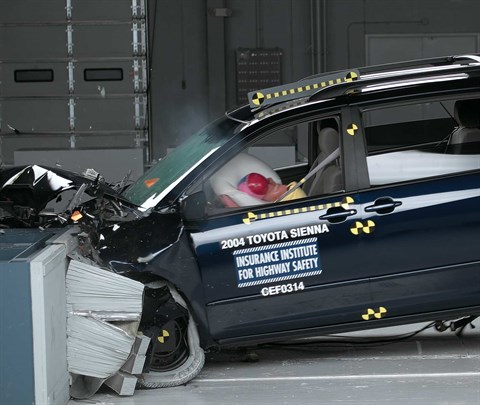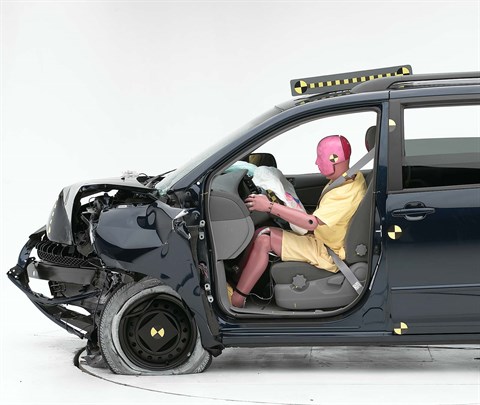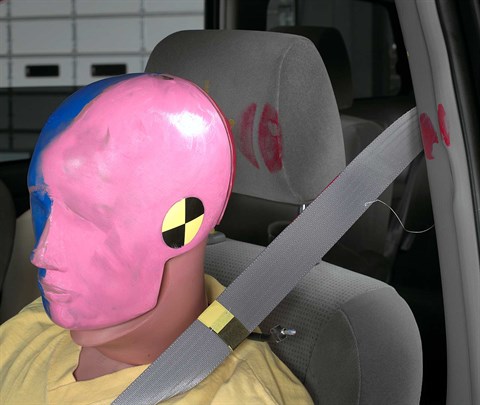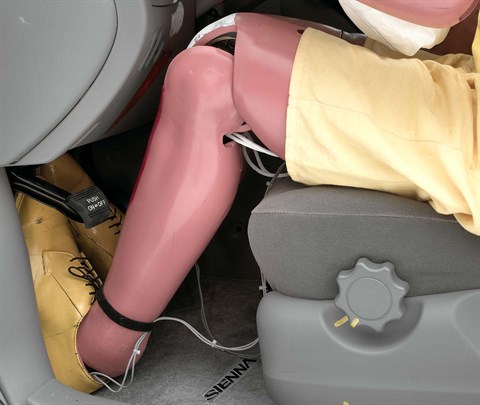Moderate overlap front: original test
Rating applies to 2004-10 models
Tested vehicle: 2004 Toyota Sienna LE
The Toyota Sienna was redesigned for the 2004 model year.
The Insurance Institute for Highway Safety has evaluated the crashworthiness of the Sienna in two 40 mph moderate overlap frontal crash tests into deformable barriers. Two tests were conducted because a major fuel leak occurred in the first test. Toyota identified a defect in the manufacturing process of the plastic fuel tank and recalled the affected models. A second test was conducted to assess the effect of the manufacturing fix. For this test, Toyota retrofitted a redesigned fuel tank into the van. Due to the similarity of results (except for the fuel leak), the evaluation of the Sienna is based on both tests.
| Evaluation criteria | Rating |
|---|---|
| Overall evaluation | |
| Structure and safety cage | |
| Driver injury measures | |
| Head/neck | |
| Chest | |
| Leg/foot, left | |
| Leg/foot, right | |
| Driver restraints and dummy kinematics | |

Action shot taken during the second of two frontal offset crash tests.

The dummy's position in relation to the steering wheel and instrument panel after both crash tests indicates that the driver's survival space was maintained well (second test shown).<strong> </strong>.

Smeared greasepaint indicates where the dummy's head hit the B-pillar and head restraint during rebound in the second test. The head rebounded similarly in the first test. Head accelerations from these hits were low in both tests.

Intrusion into the driver's space was minimal, and forces on the legs and feet were low in both tests (second test shown).
Side: original test
Rating applies to 2006-10 models
Tested vehicle: 2005 Toyota Sienna LE with optional head curtain airbags for all three rows of seats and optional front seat-mounted torso airbags
The Toyota Sienna was redesigned for the 2004 model year. Beginning with 2005 models manufactured after February 2005, changes were made to the vehicle side structure and to the optional side torso airbags to improve occupant protection in side impact crashes (note: information about when a specific vehicle was manufactured is on the certification label typically affixed to the car on or near the driver door). Beginning with 2006 models, side airbags were made standard.
Two tests of a 2005 Sienna were conducted, one with optional side airbags for the driver and rear passenger, and one without. Both were manufactured after the structural and airbag modifications had been made. These vehicles are rated separately, except that the structural ratings for both vehicles are based on both tests.
| Evaluation criteria | Rating |
|---|---|
| Overall evaluation | |
| Structure and safety cage | |
| Driver injury measures | |
| Head/neck | |
| Torso | |
| Pelvis/leg | |
| Driver head protection | |
| Rear passenger injury measures | |
| Head/neck | |
| Torso | |
| Pelvis/leg | |
| Rear passenger head protection | |

View of the vehicle and barrier just after the crash test.

View of the vehicle after the crash with doors removed, showing the side airbags and damage to the occupant compartment.

Action shot taken during the side impact crash test showing the driver dummy's head was protected from being hit by hard structures by the side curtain and side torso airbags.

Smeared greasepaint shows where the rear passenger dummy's head was protected by the side airbag.
Head restraints & seats
Seat type: Seats with adjustable lumbar
| Overall evaluation | |
|---|---|
| Dynamic rating | |
| Seat/head restraint geometry |
Seat type: Seats without adjustable lumbar
| Overall evaluation | |
|---|---|
| Dynamic rating | |
| Seat/head restraint geometry |
About the head restraint & seat test
Currently, IIHS tests apply only to front seats.
